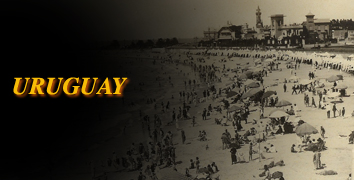
 |
| OLD
POSTCARDS FROM URUGUAY - MONTEVIDEO |
POSTAIS
ANTIGOS DO URUGUAI - MONTEVIDÉU |
 |
 |
||||||||
 |
||||||||
Clique
na miniatura para ver os postais / Click on thumbnail to view postcards |
| Montevideo |
|
| Montevideo
is Uruguay's capital, chief port, and by far its largest city. It is therefore
considered a primate city.
The Portuguese founded Colonia del Sacramento in the 17th century despite Spanish claims to the area due to the Treaty of Tordesillas. The Spanish chased the Portuguese out of a fort in the area in 1724. Then, Bruno Mauricio de Zabala - governor of Buenos Aires - founded the city on December 24, 1726 to prevent further incursions. In 1828, the town became the capital of Uruguay. There are at least two explanations for the name Montevideo: The first states that it comes from the Portuguese "Monte vide eu" which means "I see a mountain". The second is that the Spaniards recorded the location of a fountain in a map as "Monte VI De Este a Oeste" meaning "The sixth mountain from east to west". The city's full original name is San Felipe y Santiago de Montevideo. Montevideo is situated in the south of the country, at the northern mouth of the very wide River Plate (Río de la Plata) estuary. The geographic coordinates are 34.5° S, 56°W. The climate is mild, with average temperatures of approximately 13°C, achieving 40°C or more in summer.Montevideo is situated in the south of the country, at the northern mouth of the very wide River Plate (Río de la Plata) estuary. The geographic coordinates are 34.5° S, 56°W. The climate is mild, with average temperatures of approximately 13°C, achieving 40°C or more in summer. 18 de Julio, the city's main avenue and one of the finest of South America, extends from the Plaza Independencia, which is the junction between the Ciudad Vieja (the historical quarter) and the rest of the city, to the neighbourhood of Cordón Population is 1.4 million, approximately 1/3 of which is of Italian descent, a large percentage of the remainder is other white European in origin, especially Spain and Portugal — totalling some 88% of the demographic. Montevideo's population makes up roughly 44% of the entire country of Uruguay, and the surrounding province of Canelones, essentially Montevideo's suburbs and direct rural area, makes up another 12%. Uruguay's indigenous population was wiped out during the colonization period and there are virtually no descendants remaining. There is a small (8%) mestizo (mixed indigenous and European) and (4%) African population, who are, for the most part, marginalized by the rest of the community. While the dominant portion of the population is Catholic, there is also a well assimilated, but active Jewish population numbering in the 40,000s.
|
|
| Montevidéu |
|
| Montevidéu
é a capital e maior cidade do Uruguai. Localiza-se nas margens
do Rio da Prata (Río de la Plata). Foi fundada em 1726 por Bruno
Mauricio de Zabala para manter as tropas portuguesas de Manuel de Freitas
da Fonseca fora do Rio da Prata. Conquistada por Portugal em 1817, tornou-se
capital da província Cisplatina em 1821. Em 1828 passou a ser
capital do Uruguai. A capital ainda guarda vestígios de seu passado.
A Praça da Independência, a mais importante do país,
possui ainda um dos portões da antiga muralha que cercava a cidade
no período colonial. A cidade tem atrações como
teatros, muitas lojas, centro comercial e edifícios históricos
como a sede do Congresso (Palacio Legislativo), além da Catedral
(Igreja Matriz) e do Teatro Municipal (Teatro Solís). Pôr-do-sol
é no alto do Cerro onde há um antigo forte espanhol.
|
|